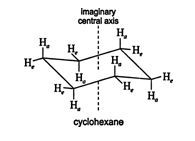Cyclohydrocarbons: Stereochemistry
Because ring compounds have restricted rotation around their carbon‐carbon single bonds, cycloalkanes with two or more substituents have cis and trans stereoisomers. For example, 1,2‐dibromobutane can exist as

Cycloalkane rings of five or fewer carbon atoms form planar or very nearly planar rings. For such molecules, cis and trans isomerism refers to the location of substituents as either on the same side of the ring plane ( cis) or on opposite sides of the ring plane ( trans). Cycloalkanes that contain six or more carbons bend out of plane, or “pucker.” For example, cyclohexane exists in three forms.

![]()
The two end structures are called chair forms, while the middle structure is called the boat form. The chair form of cyclohexane is more stable than the boat form.
Because the carbon atoms of cyclohexane form single bonds with each other, the bonds must be sp 3 hybridized. This type of hybridization creates a tetrahedral shape at each atom. Thus, the two bonds projecting from each carbon atom in the ring must form an angle of approximately 110°. This arrangement leads to the following structure.

![]()
The hydrogen atoms designated as H a occupy axial positions. Their bonds roughly parallel an imaginary axis through the center of the carbon ring. The hydrogen atoms designated as H e occupy equatorial positions. Each of these bonds is roughly 110° away from the axial bond on that carbon. Cis and trans substituent positions can be defined as those positions either on the same side ( cis) or opposite sides ( trans) of a plane that bisects the molecule through a designated pair of carbon atoms. For example, in 1,2‐disubstitutions (the substituents are represented in the diagram below as A and B), the cis‐1,2‐isomer has one substituent in the axial position and one substituent in the equatorial position.

![]()
In both cases, the A and B groups are located on the same side of the plane. Thus, equatorial‐axial substitutions lead to the cis isomer.
The trans isomer has both substituents in either axial or equatorial positions.

![]()
In both cases, the A and B groups are on opposite sides of the plane bisecting the adjacent carbons, creating trans isomers.
In 1,3‐disubstitution, axial‐axial or equatorial‐equatorial arrangement generates cis‐isomers, while axial‐equatorial substitutions lead to trans isomers.
Finally, in 1,4‐disubstitutions, axial‐axial or equatorial‐equatorial substitutions lead to the trans‐isomer, while axial‐equatorial substitutions generate the cis‐isomer.